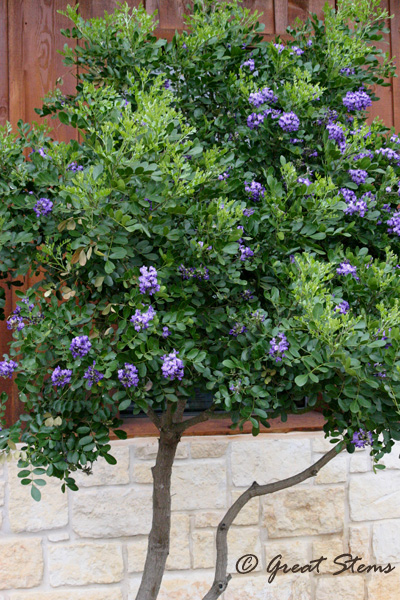 Beautiful mountain laurels in full bloom caught my eye during a recent visit to the Canyon Lake area, and I had to venture over to get a whiff of the grape-scented fragrance emitted by the flowers. Intoxicated by the scent, I paused to look around and realized that I wasn’t the only one enjoying the blooms.
Beautiful mountain laurels in full bloom caught my eye during a recent visit to the Canyon Lake area, and I had to venture over to get a whiff of the grape-scented fragrance emitted by the flowers. Intoxicated by the scent, I paused to look around and realized that I wasn’t the only one enjoying the blooms.
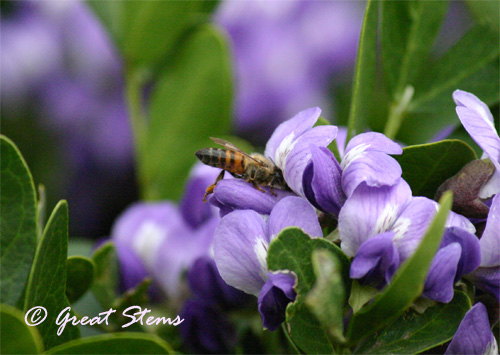 At first the honeybees caught my eye, especially as my ears sensed them, as well. They really had to push their way in to get at the nectar. If I were a bee, I would have worked hard to get in there, too — it smelled divine.
At first the honeybees caught my eye, especially as my ears sensed them, as well. They really had to push their way in to get at the nectar. If I were a bee, I would have worked hard to get in there, too — it smelled divine.
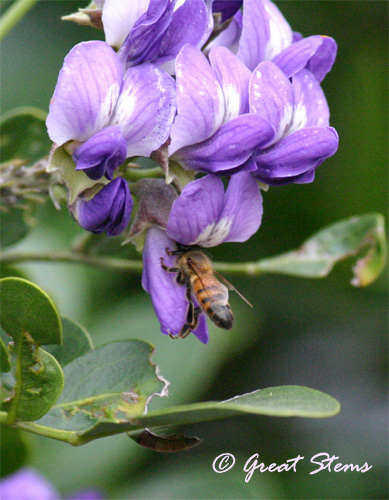 A hoverfly rested briefly on a seedpod.
A hoverfly rested briefly on a seedpod.
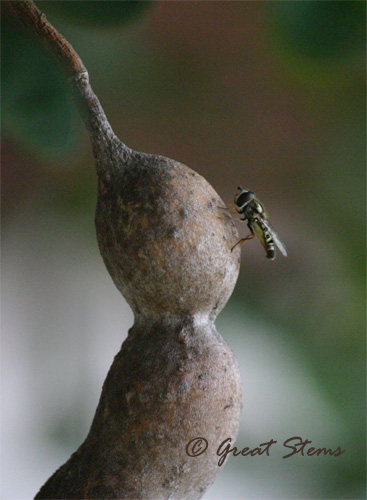 It was difficult to catch a picture of a hoverfly in the air — they didn’t hover much that day. Too busy trying to get energy refuels, I guess. But I’m fond of this motion shot, blurry that it is:
It was difficult to catch a picture of a hoverfly in the air — they didn’t hover much that day. Too busy trying to get energy refuels, I guess. But I’m fond of this motion shot, blurry that it is:
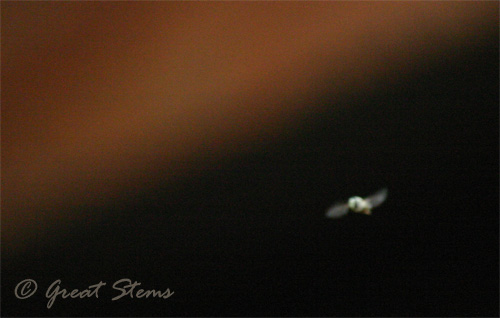
But the showstoppers of the day were the native bees, in this case metallic blue leaf-cutting bees. Dr. Jack Neff, a native bee specialist, tells me that they are likely female Osmia ribifloris, the bluest of our early season Osmia.
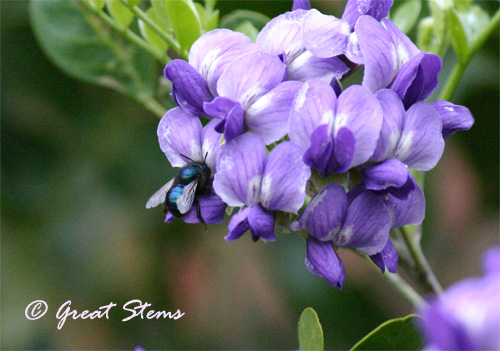
In the photo above, the bee has darker hairs on its upper thorax, while the bee below sports white pollen on her upper thorax and head hairs, with bonus yellow pollen “socks” (or at least “legwarmers”).”
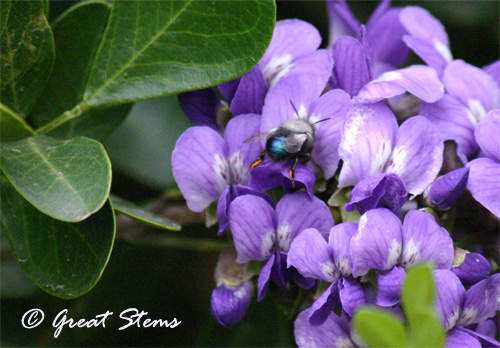
But as you can see in the next photo, the real pollen-gathering spot for this bee and other members of the Megachilidae family is on the ventral side of her abdomen, where little hairs hold the pollen she collects. This specialized area for pollen transport is called the scopa.
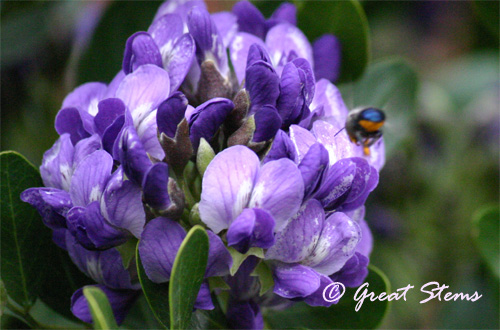 According to Dr. Neff, these lovely blue leafcutters apparently like to utilize old organ pipe mud dauber nests for their own nests, and they’ll chew leaves to make a green paste that they’ll then use to plug the nest holes. Clever little natives.
According to Dr. Neff, these lovely blue leafcutters apparently like to utilize old organ pipe mud dauber nests for their own nests, and they’ll chew leaves to make a green paste that they’ll then use to plug the nest holes. Clever little natives.
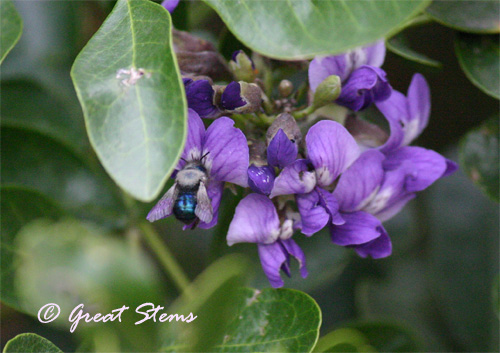
Beauties, these little bees. I feel lucky that I got to observe them for a time.
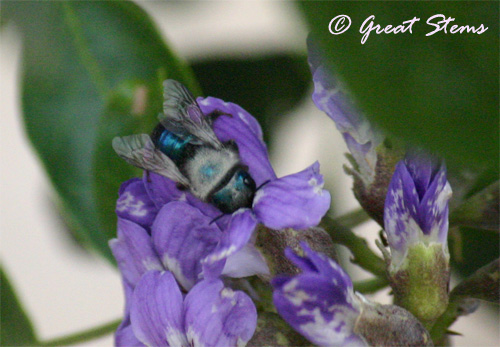 Getting back to the Mountain Laurel, inside those seed pods are the Mescal beans, as the seeds are often called, and they’re bright red and highly toxic. Some people like to take the seeds, rub them on a sidewalk to build up heat from friction, then burn the person next to them. Ouch.
Getting back to the Mountain Laurel, inside those seed pods are the Mescal beans, as the seeds are often called, and they’re bright red and highly toxic. Some people like to take the seeds, rub them on a sidewalk to build up heat from friction, then burn the person next to them. Ouch.
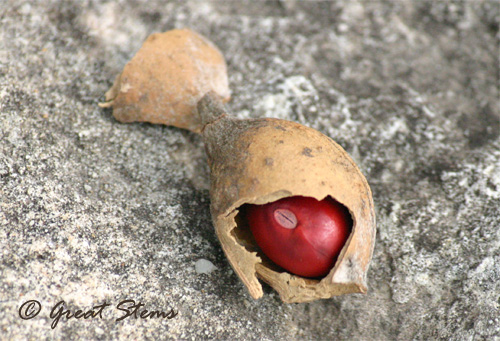 The Texas Mountain Laurel is a slow-growing, small, evergreen Texas native tree. It thrives in our Texas weather and soil and on “not being messed with” — as in plant it and then leave it alone. Since this method of gardening works for me, I have three now and counting.
The Texas Mountain Laurel is a slow-growing, small, evergreen Texas native tree. It thrives in our Texas weather and soil and on “not being messed with” — as in plant it and then leave it alone. Since this method of gardening works for me, I have three now and counting.
These are such wonderful captures, Meredith. Thank you for sharing.
what a gorgeous tree with those incredible purple flowers and its a native even better…what lovely fascinating pollinators too
If I remember right they had a grape smell. Aren’t the worms that get into the bean used in tequila? And I thing some native Americans used to use the bean as companion on road trips. This info may be stretching the truth a little. Ha.
Those details of where the bee carries pollen, are amazing pictures!
Wow, a science lesson about bees! Aren’t they the hardest working insects you’ve ever seen? They just go about their business not bothering anyone unless someone messes with them. Beautiful Texas Mountain Laurel too. Who could go wrong with a tree that is not finicky and has beautiful sweet-smelling blossoms?
I had never heard of that leaf-cutting bee before. And it looks so vibrant on the Texas Mountain Laurel with the complementary colors. Wow, these shots are spectacular!
Blue bees?! Fantastic!
Beautiful shots, and I too like the blurry hoverfly shot. Also, the tip about the friction-heated seeds was unexpected and hilarious! You were on the receiving end of the hot bean I suppose? 🙂
Great post!
Good meeting you on Saturday, Meredith!
Lovely shots of mountain laurel. I just planted my first one this spring and hope it’ll do well.
Oh my, I’m not sure which I admire more … those beautiful flowers or those amazing blue bees. They’re like little jewels amongst a treasure trove. How fascinating. Thank you so much for the close up.
Wow, thanks for introducing me to blue bees. Really beautiful and they camouflage well with the mountain laurel blooms. I can almost smell them all the over here in Georgia!
Your photos are gorgeous. Love the one you used for your banner, looks like a little hoarder.
Thanks for promoting our pollinators.
You may like to visit Texas Bee Watcher’s site-
http://www.beewatchers.com/
Love this tree, we look forward to seeing it blooming in our neighbor’s yard every year…..thinking about putting one in our backyard soon also…all of your pictures are just unbelievable….truly enjoyed each one…saved the site so I can go back and enjoy them again.
Thank you, Kathi — I hope you’ve added it to your backyard by now — if not, fall is a great time to plant!